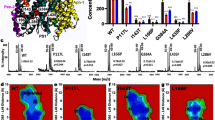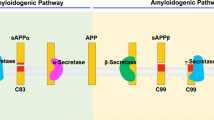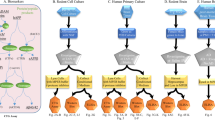Abstract
Accumulation of the amyloid-β protein (Aβ) in the cerebral cortex is an early and invariant event in the pathogenesis of Alzheimer's disease. The final step in the generation of Aβ from the β-amyloid precursor protein is an apparently intramembranous proteolysis by the elusive γ-secretase(s)1. The most common cause of familial Alzheimer's disease is mutation of the genes encoding presenilins 1 and 2, which alters γ-secretase activity to increase the production of the highly amyloidogenic Aβ42 isoform2. Moreover, deletion of presenilin-1 in mice greatly reduces γ-secretase activity3, indicating that presenilin-1 mediates most of this proteolytic event. Here we report that mutation of either of two conserved transmembrane (TM) aspartate residues in presenilin-1, Asp 257 (in TM6) and Asp 385 (in TM7), substantially reduces Aβ production and increases the amounts of the carboxy-terminal fragments of β-amyloid precursor protein that are the substrates of γ-secretase. We observed these effects in three different cell lines as well as in cell-free microsomes. Either of the Asp → Ala mutations also prevented the normal endoproteolysis of presenilin-1 in the TM6 → TM7 cytoplasmic loop. In a functional presenilin-1 variant (carrying a deletion in exon 9) that is associated with familial Alzheimer's disease and which does not require this cleavage4, the Asp 385 → Ala mutation still inhibited γ-secretase activity. Our results indicate that the two transmembrane aspartate residues are critical for both presenilin-1 endoproteolysis and γ-secretase activity, and suggest that presenilin 1 is either a unique diaspartyl cofactor for γ-secretase or is itself γ-secretase, an autoactivated intramembranous aspartyl protease.
This is a preview of subscription content, access via your institution
Access options
Subscribe to this journal
Receive 51 print issues and online access
$199.00 per year
only $3.90 per issue
Buy this article
- Purchase on Springer Link
- Instant access to full article PDF
Prices may be subject to local taxes which are calculated during checkout




Similar content being viewed by others
References
Selkoe, D. J. Cell biology of the amyloid beta-protein precursor and the mechanism of Alzheimer's disease. Annu. Rev. Cell Biol. 10, 373–403 (1994).
Hardy, J. The Alzheimer family of diseases: many etiologies, one pathogenesis? Proc. Natl Acad. Sci. USA 94, 2095–2097 (1997).
De Strooper, B. et al. Deficiency of presenilin-1 inhibits the normal cleavage of amyloid precursor protein. Nature 391, 387–390 (1998).
Levitan, D. et al. Assessment of normal and mutant human presenilin function in Caenorhabditis elegans. Proc. Natl Acad. Sci. USA 93, 14940–14944 (1996).
Haass, C. et al. Amyloid beta-peptide is produced by cultured cells during normal metabolism. Nature 359, 322–325 (1992).
Li, X. & Greenwald, I. Additional evidence for an eight-transmembrane-domain topology for Caenorhabditis elegans and human presenilins. Proc. Natl Acad. Sci. USA 95, 7109–7114 (1998).
Thinakaran, G. et al. Endoproteolysis of presenilin 1 and accumulation of processed derivatives invivo. Neuron 17, 181–190 (1996).
Podlisny, M. B. et al. Presenilin proteins undergo heterogeneous endoproteolysis between Thr291 and Ala299 and occur as stable N- and C-terminal fragments in normal and Alzheimer brain tissue. Neurobiol. Dis. 3, 325–337 (1997).
Capell, A. et al. The proteolytic fragments of the Alzheimer's disease-associated presenilin-1 form heterodimers and occur as a 100–150-kDa molecular mass complex. J. Biol. Chem. 273, 3205–3211 (1998).
Venter, J. C., Fraser, C. M., Kerlavage, A. R. & Buck, M. A. Molecular biology of adrenergic and muscarinic cholinergic receptors. Biochem. Pharmacol. 38, 1197–1208 (1989).
Koo, E. H. & Squazzo, S. L. Evidence that production and release of amyloid beta-protein involves the endocytic pathway. J. Biol. Chem. 269, 17386–17389 (1994).
Xia, W. et al. Enhanced production and oligomerization of the 42-residue amyloid beta-protein by Chinese hamster ovary cells stably expressing mutant presenilins. J. Biol. Chem. 272, 7977–7982 (1997).
Thinakaran, G. et al. Evidence that levels of presenilins (PS1 and PS2) are coordinately regulated by competition for limiting cellular factors. J. Biol. Chem. 272, 28415–28422 (1997).
Wolfe, M. S. et al. Asubstrate-based difluoroketone selectively inhibits Alzheimer's gamma-secretase activity. J. Med. Chem. 41, 6–9 (1998).
Wolfe, M. S. et al. Peptidomimetic probes and molecular modelling suggest that Alzheimer's γ-secretase is an intramembrane-cleaving aspartyl protease. Biochemistry (in the press).
Xia, W. et al. Presenilin 1 regulates the processing of β-amyloid precursor protein C-terminal fragments and the generation of amyloid β-protein in endoplasmic reticulum and Golgi. Biochem. 37, 16465–16471 (1998).
L'Hernault, S. W. & Arduengo, P. M. Mutation of a putative sperm membrane protein in Caenorhabditis elegans prevents sperm differentiation but not its associated meiotic divisions. J.Cell Biol. 119, 55–68 (1992).
Li, X. & Greenwald, I. HOP-1, a Caenorhabditis elegans presenilin, appears to be functionally redundant with SEL-12 presenilin and to facilitate LIN-12 and GLP-1 signaling. Proc. Natl. Acad. Sci. USA 94, 12204–12209 (1997).
Brockhaus, M. et al. Caspase-mediated cleavage is not required for the activity of presenilins in amyloidogenesis and NOTCH signaling. Neuroreport 9, 1481–1486 (1998).
Shen, J. et al. Skeletal and CNS defects in presenilin-1-deficient mice. Cell 89, 629–639 (1997).
Wong, P. C. et al. Presenilin 1 is required for Notch1 and DII1 expression in the paraxial mesoderm. Nature 387, 288–292 (1997).
Kovacs, D. M. et al. Alzheimer-associated presenilins 1 and 2: neuronal expression in brain and localization to intracellular membranes in mammalian cells. Nature Med. 2, 224–229 (1996).
Hua, X., Nohturfft, A., Goldstein, J. L. & Brown, M. S. Sterol resistance in CHO cells traced to point mutation in SREBP cleavage-activating protein. Cell 87, 415–426 (1996).
Rawson, R. B. et al. Complementation cloning of S2P, a gene encoding a putative metalloprotease required for intramembrane cleavage of SREBPs. Mol. Cell 1, 47–57 (1997).
Boyartchuk, V. L., Ashby, M. N. & Rine, J. Modulation of Ras and a-factor function by carboxyl-terminal proteolysis. Science 275, 1796–1800 (1997).
Levitan, D. & Greenwald, I. Effects of SEL-12 presenilin on LIN-12 localization and function in Caenorhabditis elegans. Development 125, 3599–3606 (1998).
Schroeter, R. H., Kisslinger, J. A. & Kopan, R. Notch-1 signalling requires ligand-induced proteolytic release of intracellular domain. Nature 393, 382–385 (1998).
De Strooper, B. et al. Apresenilin-1-dependent, γ-secretase-like protease mediates release of Notch intracellular domain. Nature 398, 518–522 (1999).
Johnson-Wood, K. et al. Amyloid precursor protein processing and Abeta42 deposition in a transgenic mouse model of Alzheimer disease. Proc. Natl Acad. Sci. USA 94, 1550–1555 (1997).
Zhang, J. et al. Subcellular distribution and turnover of presenilins in transfected cells. J. Biol. Chem. 273, 12436–12442 (1998).
Acknowledgements
We thank D. Watson and J. Zhang for plasmid pCI-C99, and P. Seubert for antibodies 192, 266, 3D6 and 21F12. This work was supported by grants from the NIH to M.S.W. and D.J.S.
Author information
Authors and Affiliations
Corresponding authors
Rights and permissions
About this article
Cite this article
Wolfe, M., Xia, W., Ostaszewski, B. et al. Two transmembrane aspartates in presenilin-1 required for presenilin endoproteolysis and γ-secretase activity. Nature 398, 513–517 (1999). https://doi.org/10.1038/19077
Received:
Accepted:
Issue Date:
DOI: https://doi.org/10.1038/19077
This article is cited by
-
The advent of Alzheimer treatments will change the trajectory of human aging
Nature Aging (2024)
-
Differential effects of familial Alzheimer’s disease-causing mutations on amyloid precursor protein (APP) trafficking, proteolytic conversion, and synaptogenic activity
Acta Neuropathologica Communications (2023)
-
Effects of presenilin-1 familial Alzheimer’s disease mutations on γ-secretase activation for cleavage of amyloid precursor protein
Communications Biology (2023)
-
Cholinergic-like neurons and cerebral spheroids bearing the PSEN1 p.Ile416Thr variant mirror Alzheimer's disease neuropathology
Scientific Reports (2023)
-
Enzyme-substrate hybrid β-sheet controls geometry and water access to the γ-secretase active site
Communications Biology (2023)
Comments
By submitting a comment you agree to abide by our Terms and Community Guidelines. If you find something abusive or that does not comply with our terms or guidelines please flag it as inappropriate.



